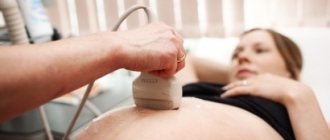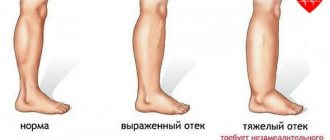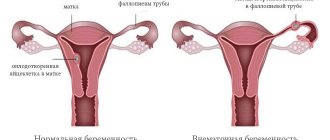Causes of edema in pregnant women
Edema occurs not only due to water changes in the body, but also due to the fact that the outflow of blood slows down significantly and enters various parts of the body at an unusual pace, especially to the lower extremities. There are several types and stages of swelling during pregnancy.
Swelling of the lower legs
Most often, pregnant women experience swelling of the legs in the area of the feet and ankles, this happens due to the fact that this part of the body receives the least amount of water and blood, the woman in this case experiences a constant feeling of thirst, and because she drinks a lot, The face and hands begin to swell at the same time.
Shoes no longer fit your feet, become tight and small, in the summer it is easier to choose new, comfortable shoes, in the winter, of course, it is more difficult, and it seems that it will only be comfortable in galoshes or felt boots.
According to the standard, swelling appears closer to the 20th week of pregnancy and can persist until childbirth.
Causes of edema:
- The uterus increases simultaneously with the growth of the fetus, thereby putting pressure on the organs and vessels that surround it. Because of this, it is difficult to remove fluid from the body, especially if the uterus puts pressure on the ureters.
- Preeclampsia is a late toxicosis that poses a threat to a pregnant woman. In this case, the outflow and supply of blood through the vessels significantly worsens, blood pressure may increase, and worst of all, tissue death may begin. Therefore, if after 20 weeks you experience nausea, vomiting or the urge to do so, you are overcome by general weakness, you need to urgently consult a doctor, and most likely you will need hospitalization.
- Glomerulonephritis is a pathological, inflammatory disease of the kidneys; very often women learn about the diagnosis during pregnancy, since, before pregnancy, the inflammatory process occurs quite slowly and asymptomatically, and worsens when the uterus puts pressure on the kidney vessels. In this case, additional medical supervision and medication support will be necessary.
- Diseases of the cardiovascular system.
- Varicose veins in the legs or hip area.
- Insufficient amount of protein entering the body through food.
Swelling of the legs is not always scary and unsafe; often mild forms of edema can be observed with excessive fluid intake, fatty or excessively salty foods.
Swelling of the hands
Before the start of the third trimester of pregnancy, women are advised to remove all rings and jewelry from their hands, as they can dig into the skin, removing them will be problematic or almost impossible, in which case the swelling will intensify and will be present constantly.
Causes of edema:
- Hormonal changes in which the pregnant woman’s body releases more progesterone, which provokes water retention.
- Fingers and hands can also swell due to viral and infectious diseases, colds, flu, etc.
- Allergic reaction to household chemicals or food.
- Overwork, improper daily routine, in which the pregnant woman spends a lot of time standing or overexerts her arm muscles.
If you notice swelling in your hands, you should immediately take a urine test and a general blood test.
Facial swelling
This does not just mean swelling of the nose, but a noticeable roundness of the entire face, as well as painful sensations of the skin when touched.
Causes of edema:
- Skin dehydration.
- Excessive pressure on veins and lymphatic vessels.
- Water-salt imbalance.
- Excessively hot weather.
With this type of swelling, it is usually enough to adhere to a special diet and light medication without hospitalization.
If your face swells
If the face swells, then we are talking about the third stage of swelling. It is impossible not to notice such swelling. The face becomes rounder. The eyelids may swell. The nose becomes noticeably larger.
Kidney diseases are manifested primarily by swelling on the face in the form of “bags” under the eyes and swollen upper eyelids. “Reserves” of fluid in the lower extremities appear later.
If you have heart problems, swelling of the nasolabial area of the face and mucous membranes may occur, which is accompanied by a bluish tint.
Often, expectant mothers experience “pregnancy runny nose.” This is the result of swelling of the mucous membranes of the nose. A woman may feel a dry nose, difficulty breathing, and sneezing. This situation not only has a bad effect on the well-being and mood of the pregnant woman, the quality of sleep, but also leads to poor blood oxygen saturation. You can get rid of this ailment using folk methods or special drops, which are not prohibited during pregnancy.
Important! Swelling of the mucous membranes can also be caused by allergies. Since the expectant mother is very vulnerable, it is worth checking all possible allergens in the house (new/cheap dishwashing liquid, air fresheners, flowering indoor plants, animals, etc.). An advanced allergy can develop into bronchial asthma.
Symptoms of edema during pregnancy
The most common symptoms of edema are:
- Weight gain, in a fairly short period of time, without significant changes in food. The rate of increase is allowed up to 300 grams per week.
- Shoes become tight and discomfort is felt when walking.
- The legs become heavy, it is difficult to even lift and lower them from/to the bed, and cramps often occur.
- High blood pressure, rapid heartbeat.
- Presence of protein in urine.
- Numbness of fingers and hands.
- Sensation of squeezing of wrists.
- Tingling sensation in fingertips.
- Slight itching and dry mucous membranes appear in the nose, which is accompanied by difficulty breathing.
- The appearance of shortness of breath when walking.
- Snoring may occur during sleep.
- “Puffiness” of the hands, swelling of the fingers and palms on the outside.
- Back pain due to swelling of the abdominal circumference and lumbosacral region, which intensifies when walking, but can be bothersome even during sleep.
- Disturbances in urination, the urge becomes less frequent, and the amount of urine is insignificant.
- Appetite is suppressed or absent.
These are a number of the main and most common symptoms that a pregnant woman experiences during swelling, but for everyone they can manifest individually and to varying degrees.
What are the dangers of edema during pregnancy?
In 80% of cases, pregnant women develop and experience edema of a physiological nature, which is easily eliminated with diet and special medications; this type of edema does not pose a threat to the health of the expectant mother and baby.
If the problem lies deeper, then this is already an alarming signal, and failure to provide proper medical care can lead to an insufficient amount of oxygen reaching the fetus, oxygen starvation will occur, which threatens fetal death with termination of pregnancy or the onset of premature birth.
Therefore, do not neglect planned visits to the doctor with whom you are registered, and in the event of a sharp deterioration in health and well-being, call an ambulance and do not refuse hospitalization if there are indications for this.
Development of edema and possible consequences
Swelling in pregnant women can manifest itself in different ways: on the legs, face, arms, even in the abdominal cavity. Depending on the location and severity, the following degrees of swelling are distinguished:
| Degree | Symptoms |
| I degree | There is a pasty state of tissue in the area of the feet and ankles |
| II degree | Swelling of the lower extremities, including the hips, affects the buttocks, lower back and lower abdomen |
| III degree | Watery hands and face |
| IV degree | Severe swelling throughout the body. |
Having discovered signs of excess fluid in the extremities, the expectant mother is interested in how to relieve swelling of the legs during pregnancy without harming the baby. But first of all, you need to find out why they appeared in order to fight the cause of the problem.
You should know that swelling is not always harmless. The accumulation of excess fluid can lead to such serious complications as:
- swelling of the placenta, which leads to malnutrition of the fetus and hypoxia;
- increased blood pressure in the mother;
- eclampsia;
- gestosis.
Attention! Only a doctor can determine whether your case is normal. A complication not detected in time can worsen the course of pregnancy and lead to pathologies in the development of the baby.
How to remove swelling during pregnancy
Drug treatment is used only as prescribed by the attending physician, after preliminary tests have been taken and the exact cause of the edema has been determined. Most often, treatment can be done at home, for a short course, followed by repeated tests.
Drugs used to treat and prevent edema in pregnant women
Canephron
A combined preparation consisting of rosemary leaves, centaury herb and lovage root. It comes in the form of alcohol-based drops, and in the form of dragees (a more suitable release form for pregnant women).
The drug strengthens the capillaries and vessels of the kidneys, improves their basic functions, has a slight (gentle) diuretic effect, and also has anti-inflammatory, antispasmodic and antiseptic effects.
Important! During treatment with Canephron, you must drink at least one liter of clean water during the day.
Phytolysin
A paste for internal use, consisting of five plants and four natural oils, is aromatic and quite pleasant to the taste. Relieves inflammation of the kidneys, spasms, has a diuretic effect, and promotes the removal of stones from the bladder. The drug is not used for pyelonephritis and other acute inflammatory processes.
Magne B6 + No-Shpa
Prescribed if the cause of edema is hidden in problems of blood circulation in tissues, blood vessels and smooth muscles. They have a strengthening and antispasmodic effect.
Vitamin E
Strengthens the walls of blood vessels, which always weaken when edema occurs, and therefore vascular fluid seeps through the vessels and spreads throughout the tissues of the whole body.
Hofitol
Choleretic drug based on artichoke. Stimulates the excretion of bile, reduces the level of urea and cholesterol in the blood, has a diuretic effect, and enhances the protective properties of the liver. It is often prescribed to pregnant women, as well as newborns, with diseases such as jaundice or digestive problems.
Furosemide
A fast-acting diuretic with a short-term effect, which helps remove excess fluid, as well as phosphates, potassium, magnesium, calcium from the body, blocks the flow of sodium into the kidneys. Prescribed in exceptional cases, as an ambulance for short-term use.
Hypothiazide
Long-acting diuretic drug. The effect lasts for a day or more, the effect of the drug begins 5-7 hours after use, so it should be taken in the first half of the day.
Important! Both drugs are contraindicated for use in the first trimester of pregnancy; they can be taken starting from the second trimester, only as prescribed by a doctor.
Venotonic ointments and gels will help relieve swelling of the legs: Troxevasin, Heparin ointment, Hepatrombin, Venitan, Lyoton.
Folk remedies for edema in pregnant women
Contrast baths
A simple and effective method, you just need to immerse your feet in hot or cold water. A hot bath can last about 5 minutes, a cold bath for about 10 seconds, so as not to provoke inflammation of the kidneys and genitourinary system. You can add a few drops of Peppermint or Eucalyptus essential oil to the water.
Massage
Foot massage using special rollers or simply with your hands, using a venotonic ointment.
Morse
Drink 1-2 glasses of homemade cranberry or lingonberry juice every day, with a minimum amount of sugar. Such drinks also have a positive effect on the immune system of the expectant mother.
Decoction
A decoction of dried apricots has a mild diuretic property; it can be drunk instead of regular tea in the morning.
Foot baths
Baths will help relieve fatigue and swelling of the legs after a long day. And with their help you can easily maintain the beauty of your legs at home. Most popular recipes:
- herbal bath: 200g of herbal mixture (chamomile flowers, mint and birch leaves), pour 2 liters of boiling water and leave to steep for 40 minutes;
- bath with baking soda: 3 tablespoons per 3 liters of water;
- for a bath with juniper berries you will need 100g for each liter of water;
- A bath with sea salt is very useful: 300 g of salt per 3 liters of water;
- bath with mustard: 3 tablespoons of dry product, pour 3 liters of water.
The herbal mixture should be poured with boiling water and left to steep for 40 minutes. You need to take a bath for 10-15 minutes.
Important! The bath should not be hot (up to 37 degrees). After the bath, remove dead skin with a pumice stone and wipe your feet dry (to avoid fungus).
Prevention of edema during pregnancy
Simple tips that can help prevent the appearance of edema and ease its progression if it has already occurred:
- Per day, you need to drink from one to one and a half liters of liquid (water, juices, fruit drinks, liquid food); you should not exceed the specified volume, since an excessive amount of water in itself can cause edema.
- Adhere to a light diet, proper nutrition, avoid eating fatty, smoked foods, and also reduce or completely eliminate salt intake, give preference to foods high in protein.
- Avoid sweet and carbonated drinks.
- Avoid prolonged exposure to heat and direct sunlight. Such weather conditions often cause swelling and general fatigue.
- You should avoid wearing shoes with high heels, very thin soles, too tight or narrow.
- After consulting with your doctor, you can purchase special compression stockings or socks that will help keep veins and blood vessels in good shape, preventing the appearance of swelling.
- The position of the body should be changed every half hour, or at least once an hour, this way you will reduce the risk of swelling, and the baby will receive enough oxygen and there will be less chance of entanglement in the umbilical cord.
- A daily foot massage before going to bed guarantees lightness in the legs in the morning, the same goes for evening foot baths, walking barefoot on the sand.
- Regularly perform light exercises, warm-up, walk as much as possible, at a moderate pace.
- You should lie down and sleep mainly on your left side; it is in this position that the least load is placed on the kidneys, due to which their work is normalized and the fluid does not have the ability to stagnate in the body. Also, blood pressure in this body position is often not prone to sudden and significant changes up or down.
Physiological edema often accompanies those women who have a large fetus or twins; in such cases, maintenance therapy is prescribed, and the symptoms go away on their own after childbirth. As soon as you discover the first few manifestations of swelling, you need to see a doctor as quickly as possible, undergo examinations, take tests, and, if necessary, do an ultrasound, so as not to trigger the problem and preserve not only your health, but also that of the baby whose life at this stage, is solely in your hands.
Rate this article: ( 2 ratings, average: 5.00 out of 5)










